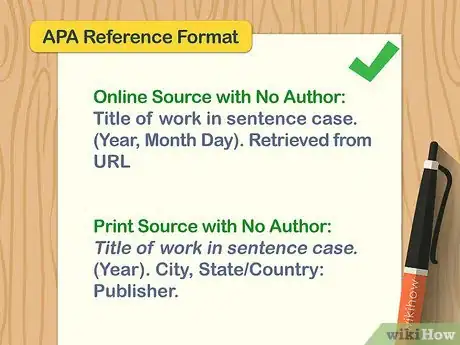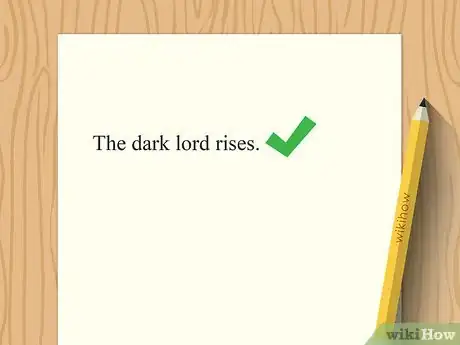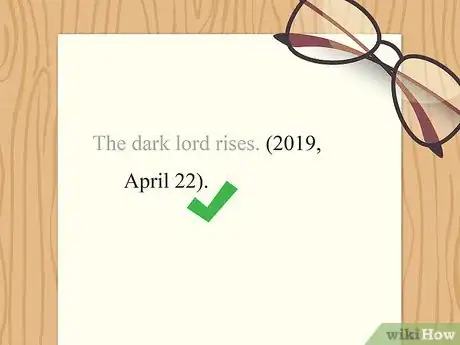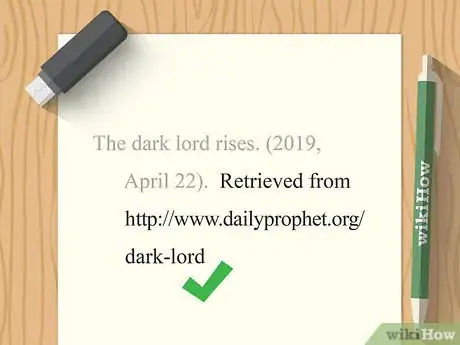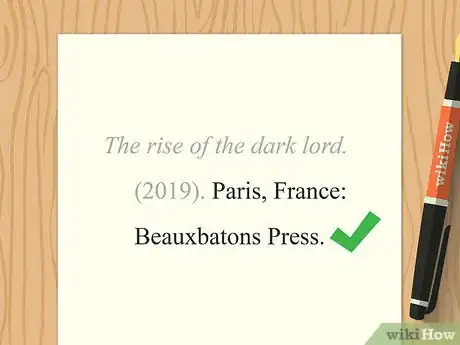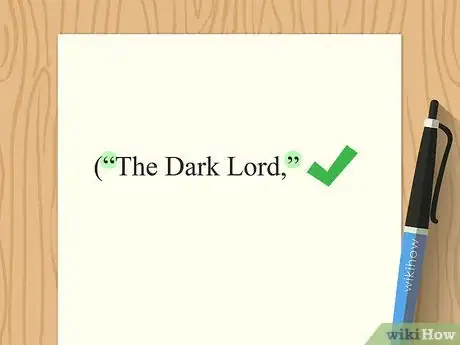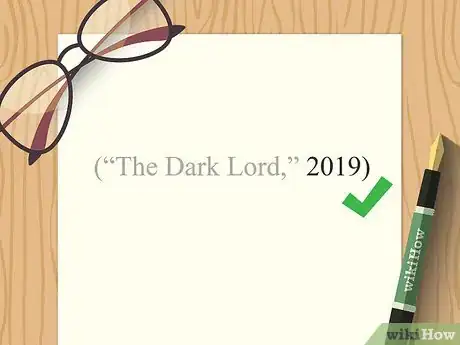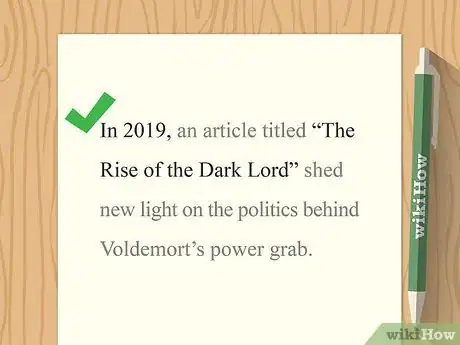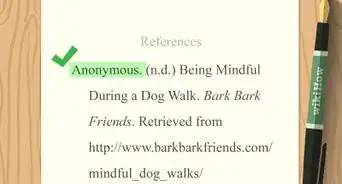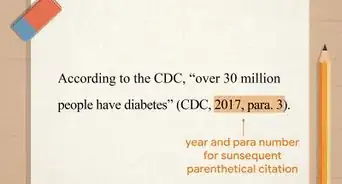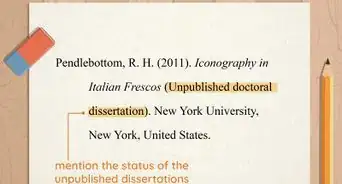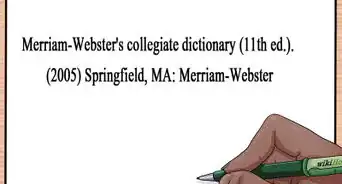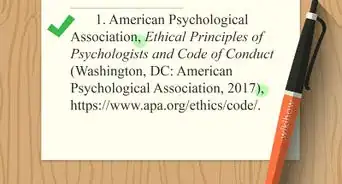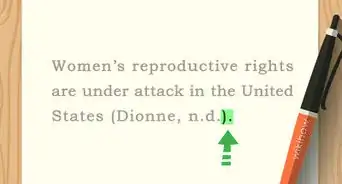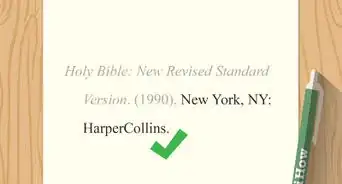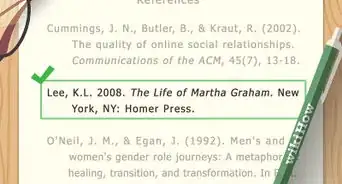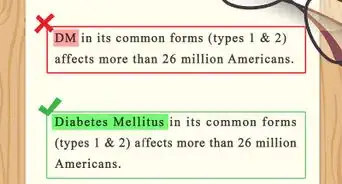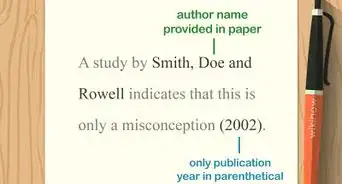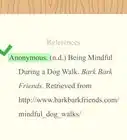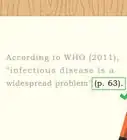This article was co-authored by wikiHow staff writer, Jennifer Mueller, JD. Jennifer Mueller is a wikiHow Content Creator. She specializes in reviewing, fact-checking, and evaluating wikiHow's content to ensure thoroughness and accuracy. Jennifer holds a JD from Indiana University Maurer School of Law in 2006.
This article has been viewed 50,298 times.
Learn more...
When you're doing research in preparation to write a paper, you may find valuable sources that don't list an individual author. However, you still need to cite these sources so your readers know that you didn't come up with the information you paraphrased from the source on your own. Generally, if you're using American Psychological Association (APA) citation style, you'll start your Reference List entry with the title of the work rather than the name of the author, then use a shortened version of the title for your parenthetical in-text citation.[1]
Steps
Reference List Entry
-
1Double-check that the source doesn't have an institutional author. If you found the source material online, you may be able to use the institution that published the material as the author. This is particularly true with material from educational institutions or nonprofit organizations, but it may also be true of corporate authors.[2]
- For example, if you're looking at a report published on the American Heart Association website that doesn't list an individual author, you would typically use the American Heart Association as the author.
- If you have a print source that doesn't list a specific person as the author, look at the copyright information. If a corporation, nonprofit organization, or educational institution claims the copyright in the work, use that name as the author.
-
2Start your reference list entry with the title of the work. Type the title of the work in sentence-case, capitalizing only the first word and any proper nouns. If the work is a standalone document, such as an independent report or a book, put the title in italics. Use regular font if the work is a smaller part of a larger work, such as a chapter or an article.[3]
- Example: The dark lord rises.
Advertisement -
3Add the date the work was published in parentheses. For most sources with no author, the year is all you need. However, if there is a more specific date listed, include as much information as possible. If you have a full date, type the year first, followed by a comma, then the month and day. Spell all months out in full. Place a period outside the closing parentheses.[4]
- Example: The dark lord rises. (2019, April 22).
-
4Provide the URL if the work was found online. After the date, type the words "Retrieved from" followed by the full, direct URL for the work. Do not place a period at the end of the URL or add an access date.[5]
- Example: The dark lord rises. (2019, April 22). Retrieved from http://www.thedailyprophet.org/dark-lord
APA Reference List Format – Online Source with No Author
Title of work in sentence case. (Year, Month Day). Retrieved from URL
-
5Include publication information if you're using a print source. If you accessed a print copy of the source, provide the location of the publisher followed by a colon, then provide the name of the publisher. If the publisher is in the US, use the city and state for the location with a 2-letter abbreviation for the state. If the publisher is outside the US, use the city and the country as the location. Place a period after the publisher's name.[6]
- Example: The rise of the dark lord. (2019). Paris, France: Beauxbatons Press.
APA Reference List Format – Print Source with No Author
Title of work in sentence case. (Year). City, State/Country: Publisher.
In-Text Citation
-
1Provide the first few words of the title in double quotation marks. At the end of any sentence in which you paraphrase or quote from the source, place a parenthetical citation that directs your reader to the full Reference List entry. Since the first part of that entry is the title, use the first few words of the title. Use title-case, capitalizing the first word and all nouns, pronouns, adjectives, adverbs, and verbs. Place a comma after the title, inside the closing double quotation marks.[7]
- Example: ("The Dark Lord,"
-
2Add the date the work was published. After the first few words of the title, include the year the work was published. If you included the month and day of publication in your Reference List entry, there is no need to include it in your in-text citation. Place your closing punctuation after the closing parenthesis.[8]
- Example: ("The Dark Lord," 2019).
Tip: If you quote directly from the source, type a comma after the date and then add the page number or page range where the quote can be found. Use "p." to indicate a single page or "pp." to indicate multiple pages.
-
3Integrate the citation information into the text of your paper. You can avoid the need to use a parenthetical citation at all if you put the citation information directly into the text of your paper. Often, this can make your paper more readable, especially if you have multiple citations in a row.[9]
- For example, you might write: In 2019, an article titled "The Rise of the Dark Lord" shed new light on the politics behind Voldemort's power grab.
- If you only included the title of the source in your paper, you would put a parenthetical immediately after the title with the year of publication. For example, you might write: Although there is no attributed author, "The Rise of the Dark Lord" (2019) is considered the most thorough documentation of Voldemort's attempted rise to power.
- If you quoted from the source directly, the parenthetical with the page number goes at the end of the quote. For example, you might write: According to "The Rise of the Dark Lord" (2019), Voldemort sought not only political control but also control over "the very hearts and minds of every witch and wizard young and old" (p. 92).
Warnings
- Sources without authors may be considered less trustworthy than those that do. If you can find the same information in a source that does have an author, your work will have more credibility. Be especially critical of online sources that do not have an author listed, unless you find them own a page you know to be reliable.⧼thumbs_response⧽
References
- ↑ https://owl.purdue.edu/owl/research_and_citation/apa_style/apa_formatting_and_style_guide/reference_list_author_authors.html
- ↑ https://columbiacollege-ca.libguides.com/apa/booksandebooks
- ↑ https://aus.libguides.com/apa/apa-no-author-date
- ↑ https://www.apastyle.org/learn/faqs/web-page-no-author
- ↑ https://www.apastyle.org/learn/faqs/web-page-no-author
- ↑ https://blog.apastyle.org/apastyle/2012/05/missing-pieces.html
- ↑ https://aus.libguides.com/apa/apa-no-author-date
- ↑ https://aus.libguides.com/apa/apa-no-author-date
- ↑ https://aus.libguides.com/apa/apa-no-author-date
